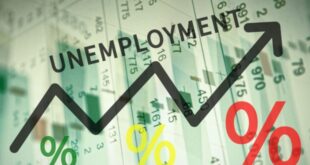That’s the viewpoint of Jay Prag, professor of economics at the Drucker School of Management at Claremont Graduate University. Prag spoke with IE Business Daily last week about why he believes the inflation isn’t going away soon, the general state of the economy and why he believes California should not be in a hurry to spend its multi-billion dollar surplus.
The following interview has been edited for clarity
QUESTION: The economy seems be doing reasonably well, post pandemic, but there are definitely some red flags. Unemployment is down, but gas prices are way up, the stock market is struggling and inflation is a major issue. Where do you see things?
ANSWER: I don’t think people have come to grips with what has happened during the last couple of years, and that’s because we’ve never had the kind of economic slowdown that we just had. What happened was totally unique.
Q: In what way?
A: The government shut down a good chunk of the economy because of COVID-19. It took a lot of jobs away, and that understandably caused a lot of anxiety. We’re still waiting to see how all of this plays out, but I agree that much of the economy has recovered.
Q: What allowed it to come back, to the extent that it has?
A: It was the economy reorganizing itself after a bad stretch. Anyone who takes credit for that, in my view, is being a little dishonest. There was no magic to it, and I don’t think it was caused by any policy.
Q: When we spoke one year ago, inflation was an issue again after having been a non-issue for years. Now it seems to be threatening the entire economy. What happened?
A: You’re right, we’re looking at pretty serious inflation right now, and that’s 99 percent the responsibility of the Federal Reserve.
Q: How so?
A: The Federal Reserve bought about $1 trillion in government bonds to make up for all of the stimulus checks that were sent out, the Paycheck Protection Act and all the rest of it. They bought the government bonds, and the government used that money to pay off what was paid out for the stimulus. In effect, they paid off the stimulus with new money, which is where the inflation is coming from.
Q: Is that what is called cheap money?
A: Yes, but what I’m talking about doesn’t stop with paying for the stimulus. The Federal Reserve also used some of that money to buy mortgage-backed securities, in order to keep mortgage rates low. That helped keep the housing industry afloat, but it also caused home prices to go up, and that shut some people out of the market. Not everyone, but some people. But that’s the nature of government spending. It helps some people, but it doesn’t help everyone.
Q: Do you think the inflation we’re seeing now is a long-term problem, or will it go away relatively quickly?
A: It’s a serious problem, and I don’t think we’re close to having it under control. I think we’re going to get to 10 percent [inflation] by the end of the year if the Federal Reserve doesn’t hit it hard. It could still be around one year from now. Inflation hits the middle class the most. It’s like a bad tax. If you’re rich you probably aren’t worried about it.
Q: It hits consumer spending very hard, obviously.
A: The way it is now it will hit a lot of things. I can see a lot of businesses, especially manufacturers, not being able to expand because it would cost too much. In the case of a manufacturer the equipment would be too expensive.
Q: One year ago you said the stimulus might be necessary under the circumstances. Now you sound critical.
A: I don’t mean to sound critical. The stimulus kept people who had lost their jobs afloat. They knew they would be able buy groceries or pay their rent. It was probably the right thing to do, but there have been consequences. We never had a slowdown before because the government deliberately shut down parts of the economy. A lot of businesses, particularly restaurants, didn’t survive.
Q: Would things have been worse if there had been no stimulus?
A: That’s possible. No one knew what do because the situation was unprecedented. I don’t like wasteful government spending, but looking back, I think what the government did was okay under the circumstances. It probably had to be done. People were very scared, and the stimulus alleviated a lot of their fears. It kept them calmed down, which was important.
Q: How would you assess the Inland Empire economy at the moment?
A: The biggest issue in the Inland Empire, and really all of California, is high housing prices. The Fed pumped a lot of money into the housing market, as we talked about, and it has artificially raised the prices of a lot of houses, especially in California. There are a lot of people who believe they’re rich because of how much the value of their house has gone up in then last couple of years, but they aren’t rich.
Q: The logistics sector carries much of the Inland Empire economy. During the worst of the pandemic it got a boost from the increase in online shopping. Do you expect a slowdown there?
- No, the Inland industrial market will be fine, I think it will keep expanding, but there’s some concern about Amazon’s announcement that they plan to unload a lot of their industrial properties and not build as much logistics as they’d planned. That could change the market a little bit.
Q: We can’t discuss the state of the economy without talking about the price of gas.
A: Gas prices are absurd. The $6-a-gallon in California is starting to cut into [automobile] sales a little bit. It’s unfortunate that this is happening at the start of the summer travel season. People will still go places, but they won’t travel as far as they have before, and that’s not good for the economy.
Q: What do you think California should do with its $97.5 billion surplus?
A: I think it should save it. There could be a downturn at some point, and the state is going to need that money to pay for some programs. So my advice would be to save it. Treat it like a rainy day fund.
Q: Why has stock market been so up and down?
A: Because it’s been been propped up by the cheap money we talked about, which is why it’s so inconsistent. It will have good weeks and bad weeks. I think it will zig and zag, at least for the rest of the year.
 IE Business Daily Business news for the Inland Empire.
IE Business Daily Business news for the Inland Empire.


